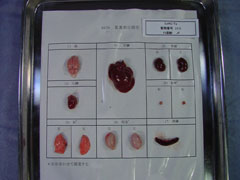| NBRP Rat No: |
Strain name: EXHC/Ta |
Commmon Name: ExHC/Ta, Exogenously hypercholesterolemic rat |
Rat Genome Database |
| Principal Investigator: |
Yuji Iizawa Takeda Chemical Industries, Ltd. 2-17-85, jusohonmati, yodogawa-ku 532-8686 Osaka Japan |
| Tel: 06-6300-6868 Fax: 06-6300-6207 |
Email: Izawa_yuji@takeda.co.jp |
| Preservation Status: |
Embryo Sperm Living Animals |
 |
 |
| Coat Color |
albino(c) |
| Inbred Generations |
F116 (Mar 2008) |
| Usage Restrictions |
"USER" shall not utilize "THE RESOUCE (ExHC/Ta)" for research The recipient of BIOLOGICAL RESOURCE shall obtain a prior written consent on use of it from the DEPOSITOR.
aimed at discovering or validating drug candidates.
Should the results obtained from the use of "THE RESOURCE (ExHC/Ta)" be published or presented at meeting or symposia, "USER" shall send the manuscript to "DEPOSITOR" prior to submitting it for publication or presentation. |
| Genetic Status |
|
| Comercial Availability |
|
|
| Research Category |
|
| Gene Affected |
|
| Origin |
EXHC rats were established from JcL:SD by repetitive inbreeding, in that a rat showing a higher serum total cholesterol was selected when fed 1% cholesterol-containing diet (Imai, 1973). (Jul 15, 2010) |
| Strain characteristics |
EXHC rats develop hypercholesterolemia for exogenous cholesterol without hypertriglyceridemia. (Imai, 1973; Imaizumi, 1992)
Significant QTLs for serum total cholesterol levels were mapped on rat chromosome 5 and 14 (Dihc1 and Dich2, respectively) (Asahina, 2005). SMEK2 was identified as a candidate gene for Dich2 (Asahina, 2009).
Fed a high cholesterol diet, EXHC rats develop proteinuria and characteristic glomerular lesion (Hattori, 1993; Miyazaki, 1997). (Jul 15, 2010) |
| Breeding Conditions |
|
| Genotyping |
|
| References |
Imai Y, Matsumura H.
Genetic studies on induced and spontaneous hypercholesterolemia in rats.
Atherosclerosis. 1973 Jul-Aug;18(1):59-64.
Imaizumi K, Nagatomi A, Sato M, Tominaga A, Sugano M.
Cholesterol metabolism in ExHC (exogenous hypercholesterolemic) rats.
Biochim Biophys Acta. 1992 Jan 3;1123(1):101-9.
Asahina M, Sato M, Imaizumi K.
Genetic analysis of diet-induced hypercholesterolemia in exogenously hypercholesterolemic rats.
J Lipid Res. 2005 Oct;46(10):2289-94.
Asahina M, Haruyama W, Ichida Y, Sakamoto M, Sato M, Imaizumi K.
Identification of SMEK2 as a candidate gene for regulation of responsiveness to dietary cholesterol in rats.
J Lipid Res. 2009 Jan;50(1):41-6.
Hattori M, Yamaguchi Y, Kawaguchi H, Ito K.
Characteristic glomerular lesions in the ExHC rat: a unique model for lipid-induced glomerular injury.
Nephron. 1993;63(3):314-22.
Miyazaki K, Isbel NM, Lan HY, Hattori M, Ito K, Bacher M, Bucala R, Atkins RC, Nikolic-Paterson DJ.
Up-regulation of macrophage colony-stimulating factor (M-CSF) and migration inhibitory factor (MIF) expression and monocyte recruitment during lipid-induced glomerular injury in the exogenous hypercholesterolaemic (ExHC) rat.
Clin Exp Immunol. 1997 May;108(2):318-23. |
| Additional strain information |
|
|
|